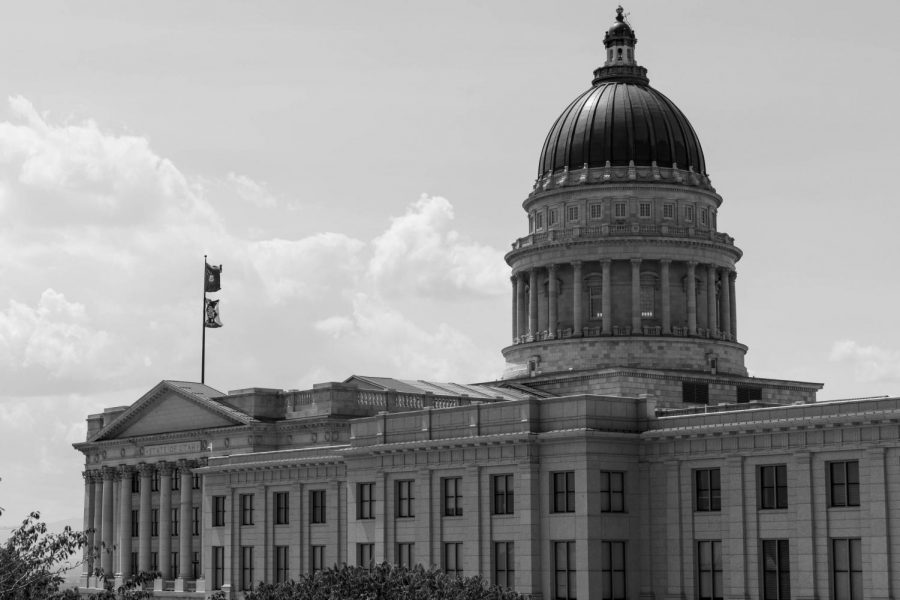Cushman: Our Legislators Consistently Fail Sexual Assault Survivors
A view of the Utah State Capitol Building in Salt Lake City on Aug. 21, 2021. (Photo by Kevin Cody | The Daily Utah Chronicle)
March 2, 2023
This legislative session, Rep. Carol Moss sponsored H.B. 334. If passed, it would teach middle and high school students about sexual coercion, grooming and resources for survivors. However, this bill won’t pass. It’s been put on hold, something that I doubt surprised Rep. Moss, who has sponsored similar legislation three times and seen it fail each time. It also doesn’t surprise me, as I’ve seen how our state fails to take the necessary steps to stop sexual violence. H.B. 334’s failure is an indictment on our legislators who consistently fail sexual assault survivors.
Rape is the only violent crime in Utah perpetrated at higher rates than the national average. One in six women and one in 25 men will experience rape or attempted rape in our state. One in three women will experience some form of sexual assault. I have read and written these statistics time after time as I’ve covered sexual violence in Utah, but they always stay the same. In fact, our state has had rape rates above the national average for over two decades. These statistics make it all the more concerning when state legislators bury legislation like H.B. 334, which aim to prevent sexual violence and help young survivors find resources.
Prevention
The Utah Coalition Against Sexual Assault (UCASA) explains three levels of sexual violence prevention. Primary prevention aims to stop sexual violence before it happens. Secondary prevention happens in the immediate aftermath of an assault. Tertiary preventions are long-term responses after sexual violence has occurred.
H.B. 334’s educational provisions include “sexual violence behavior prevention education.” Educating young people on sexual assault and how to prevent it can deter them from perpetration. Simply put, if people understand how not to coerce or force intimacy, they are less likely to engage in sexually violent behavior. That makes this a prime example of primary prevention, but H.B. 334 also has the potential to help in secondary and tertiary prevention.
The bill’s requirement to educate young people on “sexual assault resource strategies” would give Utah students the tools they need to “address physical and psychological effects of [a] sexual assault.” It makes young people aware of and more likely to seek resources and help after an assault. This addresses secondary prevention.
Finally, it’s important to acknowledge that people who experience assault or rape don’t always recognize that as their experience. They might feel that something wrong happened or struggle with trauma, but don’t have the language to describe it. A review of 28 studies found that, on average, 60.4% of women who experienced rape did not recognize their experience as rape even though it fit the definition.
Young people need to know what sexual assault is to know if and when it happens to them. That knowledge will allow them to take advantage of resources like rape crisis centers or to have a rape examination done. That’s another key aspect of secondary prevention.
The knowledge of what sexual assault is, and an education that teaches survivors that experiencing an assault is never their fault, could encourage more people to report to police. Only 11.8% of sexual assault and rape victims in Utah report to law enforcement. That means perpetrators often face no consequences. While no victim needs to go to law enforcement or through the criminal justice process if they do not want to, every victim should have the fullest education to guide them in that decision. Survivors should know that they have the option to hold their perpetrators legally accountable, which addresses tertiary prevention.
Listening to Survivors
This bill checks so many boxes in preventing sexual violence. Multiple sexual assault survivors even spoke in favor of H.B. 334 before it was put on hold. Those survivors, people who had experienced childhood and adult sexual abuse, said that the education H.B. 334 could give Utah’s students would have impacted their experiences. It would have taught them the reality of what they experienced and that resources existed to help them. In my own life, I only learned about many of these resources after I experienced sexual violence and struggled to cope on my own. I struggled with feelings of guilt that could have been mitigated if I’d received education on sexual violence as a young person.
Survivors have spoken from lived experience that this legislation could have helped them or children experiencing the same kinds of abuse. Yet, our legislators ignored them and buried this bill. It shows a lack of care for survivor experiences. It shows a willful disregard of policies that could help future survivors, or better yet, make it so less people have to survive sexual violence.
H.B. 334 has been dubbed “controversial” in its previous iterations because it had provisions about teaching consent. This year, it faced opposition from parents who want sex education to remain parent-controlled. None of these reasons are enough for me — not when so many people, including children, face sexual violence without any education to help them.
I’m tired of writing about sexual violence statistics only to watch our legislators actively bury legislative solutions. I’m tired of sharing my own story about being violated only to watch as our legislators ignore the recommendations and wishes of other survivors. I truly hope those who have opposed this legislation year after year feel ashamed about how their actions leave young people vulnerable to sexual violence and minimize survivors. More than that, I hope our state leaders will take sexual violence as seriously as it deserves.








